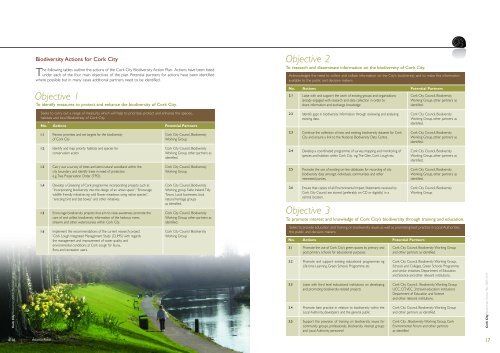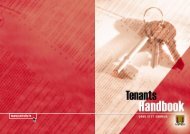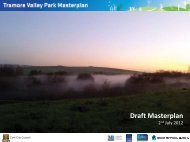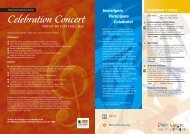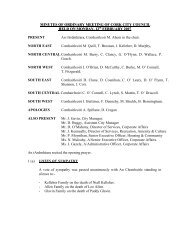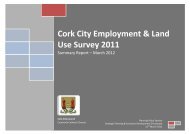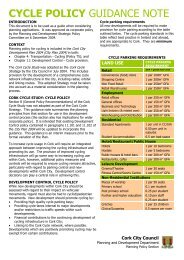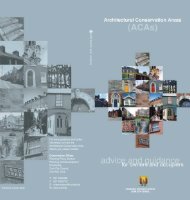Cork City's Biodiversity Action Plan - The Heritage Council
Cork City's Biodiversity Action Plan - The Heritage Council
Cork City's Biodiversity Action Plan - The Heritage Council
Create successful ePaper yourself
Turn your PDF publications into a flip-book with our unique Google optimized e-Paper software.
<strong>Cork</strong> City’s <strong>Biodiversity</strong> - an overviewDesignated sites for Nature Conservation within <strong>Cork</strong> City<strong>The</strong> habitats, flora and fauna of several areas within <strong>Cork</strong> City’s boundary are deemedworthy of protection under national and international legislation.Did you know?Icelandic-breeding BlacktailedGodwits (LimosaLimosa) migrate to spendwinter in Britain, Ireland andthe Iberian Peninsula. Of thetotal population of around50,000, 2% spend winterin <strong>Cork</strong> Harbour.Black Tailed Godwit(Limosa limosa)Globally, 2500 godwits havebeen marked with anindividual combination ofcoloured plastic rings ontheir legs. Observers all overEurope report sightings ofthese birds. In this wayhundreds of individual birdsmovements have beentracked over the last10 years.This phenomenaldataset has revealed thatthese long lived migratoryshorebirds return year afteryear to the same estuaryand has enabled researchersto identify important sitesfor conservation.Douglas Estuary and western section of Lough MahonDouglas Estuary is a proposed Natural <strong>Heritage</strong> Area (pNHA 1046) and is a large area thatincludes the Douglas River Estuary itself together with the western intertidal area of LoughMahon (including Ringmahon Strand, Lakeland Strand) as far as Blackrock Castle. In addition tointertidal mudflats, the designated area contains several habitats that are rare and important inthe city and which are also deemed of national importance. One example is the habitat ‘reedand large sedge swamp’ which comprises areas of the tall Common Reed (Phragmites australis).Saltmarsh also occurs, which is a band of vegetation occurring in the intertidal zone, betweenland and sea, comprising uniquely-adapted plants that can cope with not only the twice-dailyinundation of the tide but also the light and drying effects of the air when the tide is out. Areasof brackish/freshwater marsh also occur in the very inner sections of Douglas Estuary (nearJoe McHugh Park), a rare habitat nowadays in the city and perhaps a remnant of the city’smarshy origins while an artificial lagoon created by the old railway bridge (along the northernshore of Douglas Estuary) is a man-made, yet important habitat for many species. <strong>The</strong>sehabitats all support a diversity of birds, mammals and invertebrates that for the large part, goun-noticed from day to day. For example, the first Irish record of the moth Twin-spottedWainscot (Archanara geminipuncta) was from the reedbed at the head of Douglas Estuary.A more obvious and characteristic group of animals that use Douglas Estuary are the wadingbirds and wildfowl collectively called ‘waterbirds’ that flock to <strong>Cork</strong> Harbour and DouglasEstuary each winter. Many of these species have migrated long distances from Arctic breedinggrounds. <strong>The</strong> main reason for their presence is the plentiful supply of invertebrate prey thatlive within the intertidal mudflats that become exposed and available to eat when the tide isout. Great numbers of waterbirds visit <strong>Cork</strong> Harbour each winter and the area is classed ofinternational importance with waterbird numbers exceeding 25,000 each winter. DouglasEstuary, important in itself and designated as a Wildfowl Sanctuary, is an integral part of <strong>Cork</strong>Harbour and together with mudflats around Blackrock Castle and Dunkettle are includedwithin the area designated as the <strong>Cork</strong> Harbour Special Protection Area, one of the mostimportant wintering grounds for waterbirds in Ireland.In terms of bird numbers, Douglas Estuary is extremely important and supports significantproportions of Golden Plover (Pluvialis apricaria) and Bar-tailed Godwit (Limosa lapponica).<strong>The</strong>se species are given special protection under Annex I of the Birds Directive, together withothers including Shelduck (Tadorna tadorna), Black-tailed Godwit (Limosa limosa) and Lapwing(Vanellus vanellus). As well as the intertidal mudflats, semi-natural habitats adjacent to theestuary, including grassland fields, are also important for feeding and roosting birds.<strong>Cork</strong> City <strong>Biodiversity</strong> <strong>Action</strong> <strong>Plan</strong> 2009-2014Atlantic Salmon (Salmo salar) leaping up weir7


